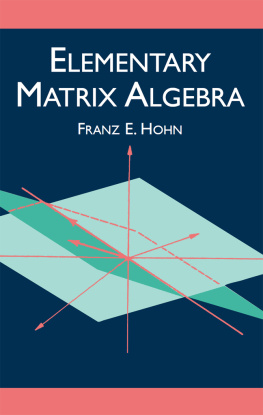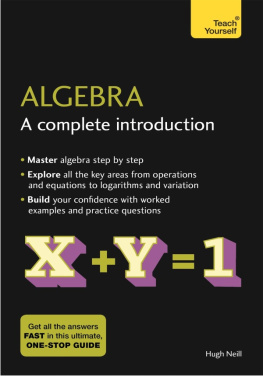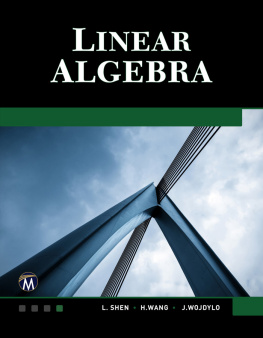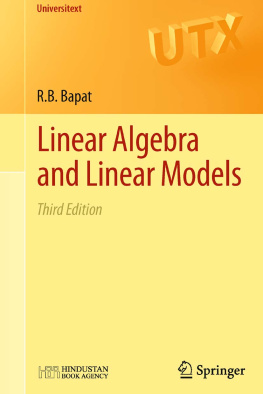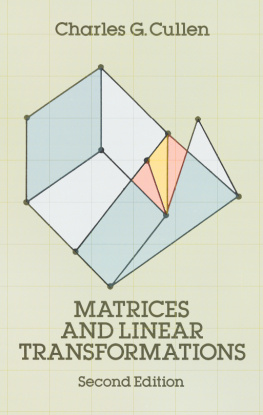Franz E. Hohn - Elementary Matrix Algebra
Here you can read online Franz E. Hohn - Elementary Matrix Algebra full text of the book (entire story) in english for free. Download pdf and epub, get meaning, cover and reviews about this ebook. year: 2012, publisher: Dover Publications, genre: Science. Description of the work, (preface) as well as reviews are available. Best literature library LitArk.com created for fans of good reading and offers a wide selection of genres:
Romance novel
Science fiction
Adventure
Detective
Science
History
Home and family
Prose
Art
Politics
Computer
Non-fiction
Religion
Business
Children
Humor
Choose a favorite category and find really read worthwhile books. Enjoy immersion in the world of imagination, feel the emotions of the characters or learn something new for yourself, make an fascinating discovery.
- Book:Elementary Matrix Algebra
- Author:
- Publisher:Dover Publications
- Genre:
- Year:2012
- Rating:3 / 5
- Favourites:Add to favourites
- Your mark:
- 60
- 1
- 2
- 3
- 4
- 5
Elementary Matrix Algebra: summary, description and annotation
We offer to read an annotation, description, summary or preface (depends on what the author of the book "Elementary Matrix Algebra" wrote himself). If you haven't found the necessary information about the book — write in the comments, we will try to find it.
Elementary Matrix Algebra — read online for free the complete book (whole text) full work
Below is the text of the book, divided by pages. System saving the place of the last page read, allows you to conveniently read the book "Elementary Matrix Algebra" online for free, without having to search again every time where you left off. Put a bookmark, and you can go to the page where you finished reading at any time.
Font size:
Interval:
Bookmark:
ALGEBRA
ALGEBRA
Elementary matrix algebra / Franz E. Hohn.3rd ed. p. cm. Originally published: 3rd ed. New York: Macmillan, [1973].
Includes bibliographical references and index. ISBN 0-486-42534-7 (pbk.) 1. Matrices. I. Title. QA188.H63 2002 512.9434dc21 2002031299 Manufactured in the United States by Courier Corporation 42534702 www.doverpublications.com PREFACE TO THE THIRD EDITION The third edition of Elementary Matrix Algebra is designed for the same audience and has the same scope as earlier editions.
As before, full and clear exposition, complemented by many illustrative examples, is a basic characteristic of this book. The purpose is to provide a text that can teach by itself. The detailed exposition and the many examples, which the student can study on his own, make it possible to progress very rapidly through the following pages. There are, however, two major changes. The first of these is that substantial geometrical material has been introduced early in the text. This helps to give a good intuitive basis for the following treatment of vector spaces.
The second and more important change is that the chapter on determinants has been deferred until it is essential for following work. This serves to place maximum emphasis on the basic concepts and methods of linear algebra. Other changes include simplification of the notation wherever possible, a more coherent arrangement of the material, and expansion of the lists of exercises, many of which refer to applications. , Quadratic, Bilinear, and Hermitian Forms, the main emphasis is placed on real quadratic forms. Definiteness receives special attention because of its importance in applications. There is considerably more material here than can be offered in a one-semester course unless the students have already been introduced to linear algebra in their calculus courses.
The purpose is to provide a degree of choice so differing interests can be met, to make the book useful for students with varying backgrounds, and to provide a fairly comprehensive reference volume. The approach is frankly computational since the book is intended for those who use matrix algebra as a tool. However, the treatment is fully rigorous and the sequencing of topics is mathematically sound. The intent is to guarantee that the study of this book will make a following, mature study of linear algebra a more rewarding experience than it might otherwise have been. A book like this cannot be prepared without substantial assistance from others. Thanks for good help go to Mrs.
Carolyn Bloemker, who did the typing, to Professor Donald R. Sherbert, who read the proof critically, to the editors of The Macmillan Company, in particular Mr. Leo Malek, who have produced a most attractive volume, to the very capable printers and compositors, and to my wife, Mrs. Marian Hohn, who has been patient and helpful throughout the long processes of revision and production. To all of them, I am deeply grateful. FRANZ E.
HOHN Urbana, IllinoisPREFACE TO THE SECOND EDITION This second edition of Elementary Matrix Algebra retains the point of view and the scope of the first edition. Some of the topics have been reordered to make the exposition simpler. For example, the partitioning of matrices is now treated in . Thus the material on the Laplace expansion may be omitted entirely if that is desired since it is not essential to later developments. Similar changes occur in following chapters. A number of topics which are useful in applications (projections, for example) have been introduced in various places.
This has been done in such a way that these topics need not be made part of the classroom work. An exceptionally detailed index, referencing also symbols and those exercises which contain important contributions to the theory, has been provided. Finally, a number of errors have been corrected and a great many new exercises have been included. It is hoped that the net effect of all these changes is to make the book easier to read and more useful as a text and as a reference. Exactly the same type of course can be taught from it as before. The author wishes to thank his colleagues, Professors Richard L.
Bishop and Hiram Paley, for their careful reading of the revised manuscript and of the proof, respectively. Many corrections and improvements are the direct result of their efforts. Professor Gene Golub provided a number of interesting and important exercises. Thanks are also due the many users of the first edition who have sent the author helpful suggestions, exercises, corrections, and letters of encouragement. Finally, the author is most grateful to the staff of The Macmillan Company and to the printers for their exceptionally cordial and able assistance. FRANZ E.
HOHN Philo, IllinoisPREFACE TO THE FIRST EDITION This text has been developed over a period of years for a course in Linear Transformations and Matrices given at the University of Illinois. The students have been juniors, seniors, and graduates whose interests have included such diverse subjects as aeronautical engineering, agricultural economics, chemistry, econometrics, education, electrical engineering, high speed computation, mechanical engineering, metallurgy, physics, psychology, sociology, statistics, and pure mathematics. The book makes no pretense of being in any sense complete. On the other hand, to meet as well as possible the needs of so varied a group, I have searched the literature of the various applications to find what aspects of matrix algebra and determinant theory are most commonly used. The book presents this most essential material as simply as possible and in a logical order with the objective of preparing the reader to study intelligently the applications of matrices in his special field. The topics are separated so far as possible into distinct, self-contained chapters in order to make the book more useful as a reference volume.
With the same purpose in view, the principal results are listed as numbered theorems, identified as to chapter and section, and printed in italics. Formulas are similarly numbered, but the numbers are always enclosed in parentheses so as to distinguish formulas from theorems. Again for reference purposes, I have added appendices on the and notations and on the algebra of complex numbers, for many readers will no doubt be in need of review of these matters. The exercises often present formal aspects of certain applications, but no knowledge of the latter is necessary for working any problem. To keep down the size of the volume, detailed treatment of applications was omitted. The exercises range from purely formal computation and extremely simple proofs to a few fairly difficult problems designed to challenge the reader.
I hope that every reader will find it possible to work most of the simpler exercises and at least to study the rest, for many useful results are contained in them, and, also, there is no way to learn the techniques of computation and of proof except through practice. The exercises marked with an asterisk (*) are of particular importance for immediate or later use and should not be overlooked. In order to make the learning and the teaching of matrix algebra as easy as possible, I have tried always to proceed by means of ample explanations from the familiar and the concrete to the abstract. Abstract algebraic concepts themselves are not the prime concern of the volume. However, I have not hesitated to make an important mathematical point where the need and the motivation for it are clear, for it has been my purpose that in addition to learning useful methods of manipulating matrices, the reader should progress significantly in mathematical maturity as a result of careful study of this book. In fact, since the definitions of fields, groups, and vector spaces as well as of other abstract concepts appear and are used here, I believe that a course of this kind is not only far more practical but is also better preparation for later work in abstract algebra than is the traditional course in the theory of equations.
Font size:
Interval:
Bookmark:
Similar books «Elementary Matrix Algebra»
Look at similar books to Elementary Matrix Algebra. We have selected literature similar in name and meaning in the hope of providing readers with more options to find new, interesting, not yet read works.
Discussion, reviews of the book Elementary Matrix Algebra and just readers' own opinions. Leave your comments, write what you think about the work, its meaning or the main characters. Specify what exactly you liked and what you didn't like, and why you think so.

